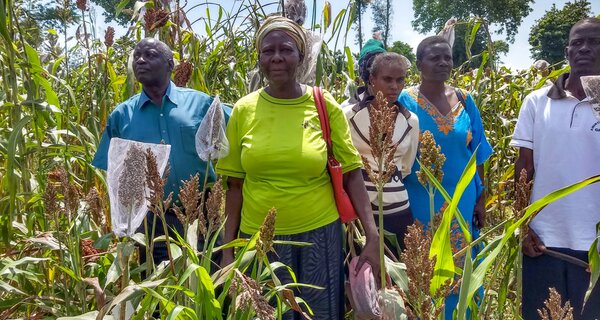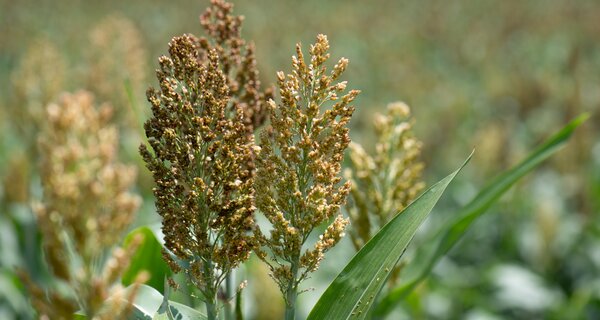Farmers in Mali Go Wild for Sorghum
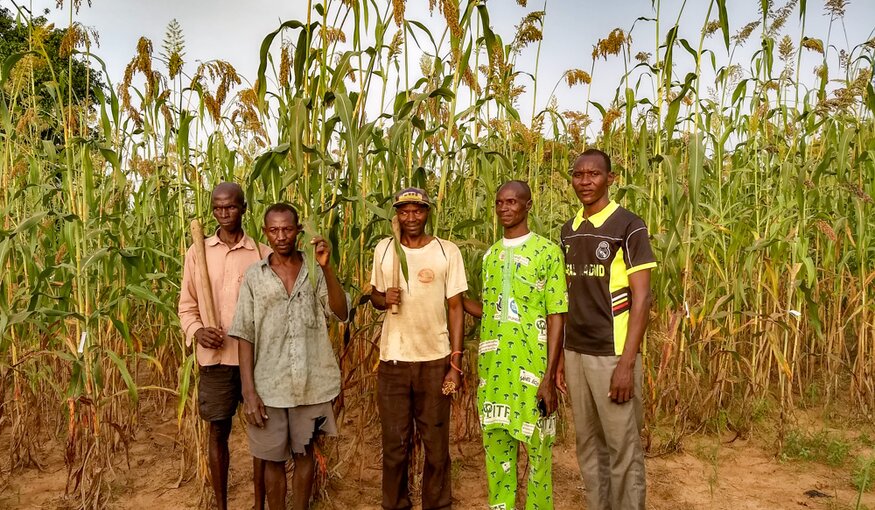 Farmers from Sokoro village who conducted the sorghum evaluation trials (left to right: Sina Mounkoro, Michel Mounkoro, Brafo Mounkoro, Moise Mounkoro and Bakary Kone). The photo shows the diversity of sorghum in the trial, each row being genetically different. They mostly have the drooping panicles of the local varieties, but differ in height, earliness, and other traits. Photo: Aly Boubacar
Farmers from Sokoro village who conducted the sorghum evaluation trials (left to right: Sina Mounkoro, Michel Mounkoro, Brafo Mounkoro, Moise Mounkoro and Bakary Kone). The photo shows the diversity of sorghum in the trial, each row being genetically different. They mostly have the drooping panicles of the local varieties, but differ in height, earliness, and other traits. Photo: Aly Boubacar30 January 2023
Moïse Mounkoro held three cards in his hand – one red, one yellow and one white. He felt like he was the football umpire in his local village of Sokoro in east central Mali.
He pulled out a red card, not to eject a player from the pitch though, but to reject a plot of sorghum. He moved on to the next plot, and this time liked what he saw. It was tall, the grains were large and the panicles holding them were drooping. He placed a white card at the end of the plot to mark his approval.
Moïse is the president of his local farmers’ cooperative, and indeed of the union of cooperatives in his district, the Union des Agriculteurs du Cercle de Tominian (UACT). He knows that the changing climate is impacting the sorghum his members grow in their fields, and that if they are to preserve their livelihood and food security, they must plant new, better varieties.
He therefore organized UACT members into groups with specialized interests, like testing new varieties, or growing pure seed of new varieties, or processing their harvests into ready-to-cook meals for marketing in nearby cities. As a result of his leadership, UACT has attracted the attention of agricultural researchers, in the country and beyond.
For three years, Moïse called on his variety testing teams in four villages to coordinate on-farm evaluation trials of sorghum as part of the recently completed Crop Wild Relatives (CWR) Project.
The sorghum they grew and rated with their colored cards was in many ways similar to the variety they normally plant. But these new types were actually about a quarter wild. Crop breeders had crossed a variety much liked by local farmers with its distant wild cousins from the edge of the Sahara Desert further north in Mali. Those wild sorghums are well adapted to environmental hardships and are now helping the crop become hardier too.
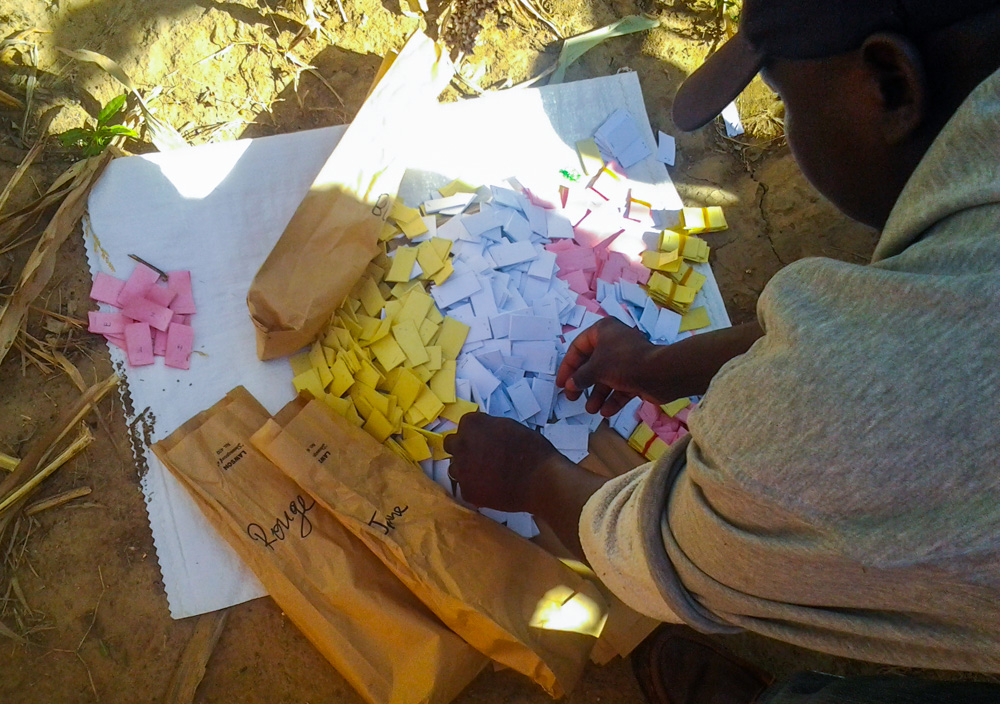
Farmers voted for their favorite sorghum using cards of different colors. Photo: Aly Boubacar

Aly Boubacar (left) consults with Colette Ouedraogo, who conducted her PhD studies on the performance of crosses between wild and cultivated sorghum for yield and farmer acceptance under various conditions. Photo: Eva Weltzein
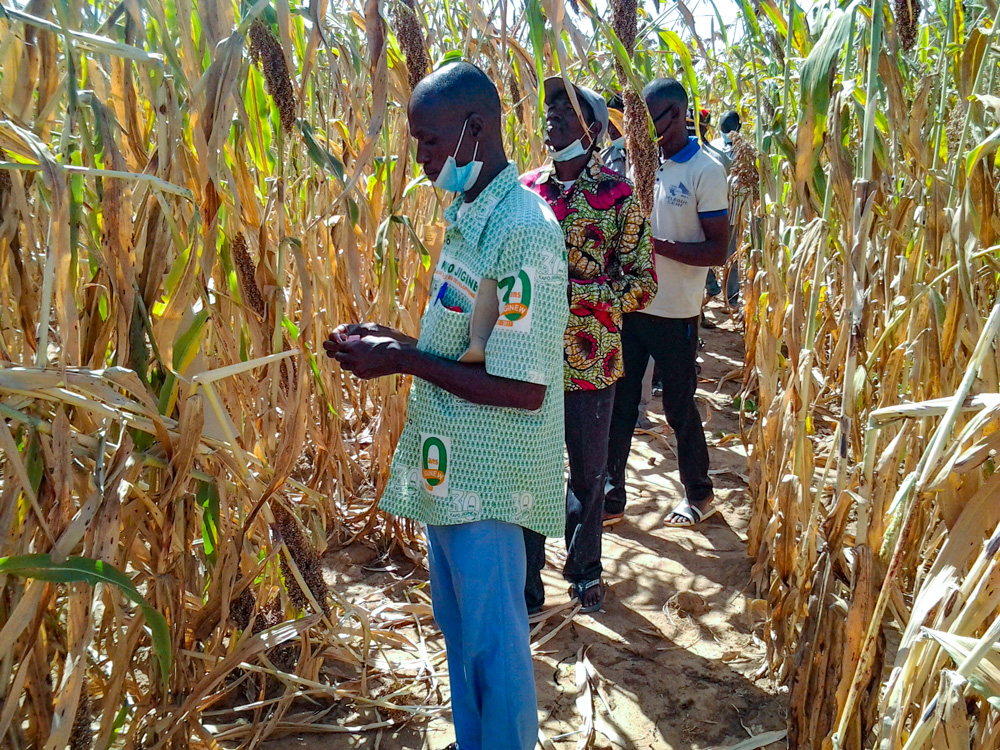
Moïse Mounkoro (left) and other Malian farmers voting for their preferred sorghum lines at Cinzana Research Station in November 2020. Photo: Aly Boubacar

Eva Weltzein evaluates sorghum in Mali. Photo: Colette Ouedraogo
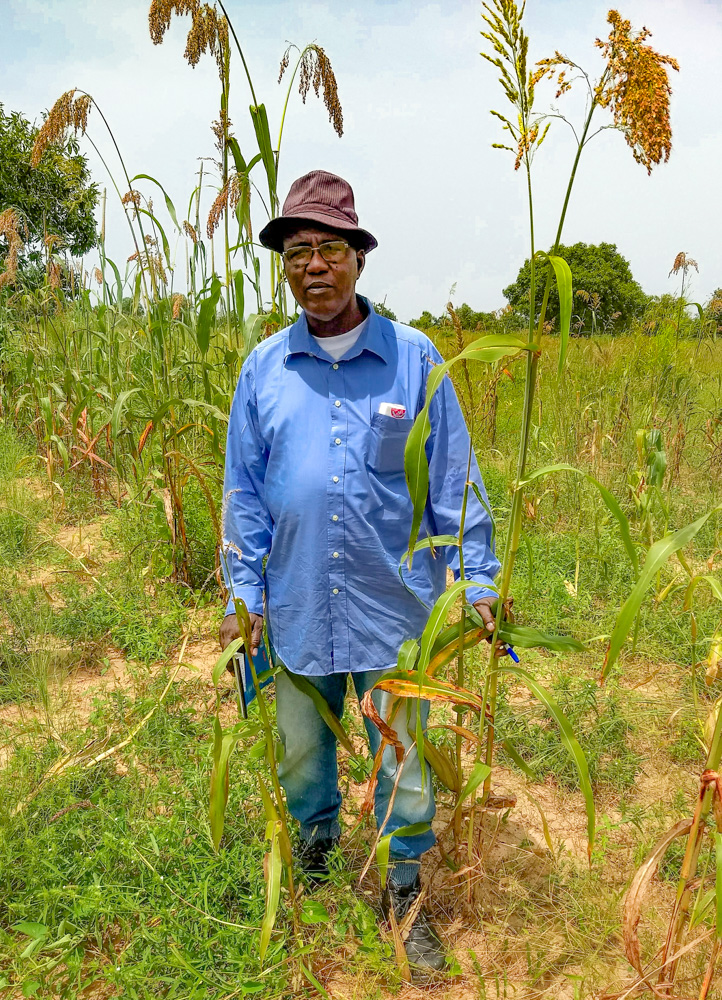
Aly Boubacar in the field of a sorghum farmer. Photo: Eva Weltzein
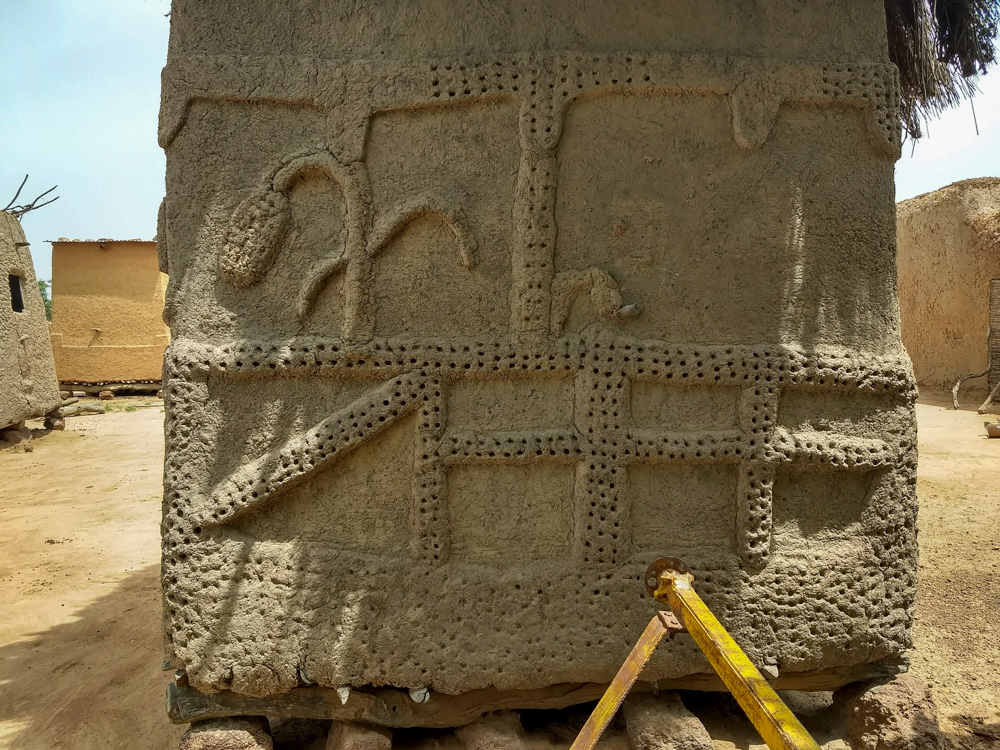
Sorghum has been embedded in the culture of Mali for generations. Photo: Eva Weltzein
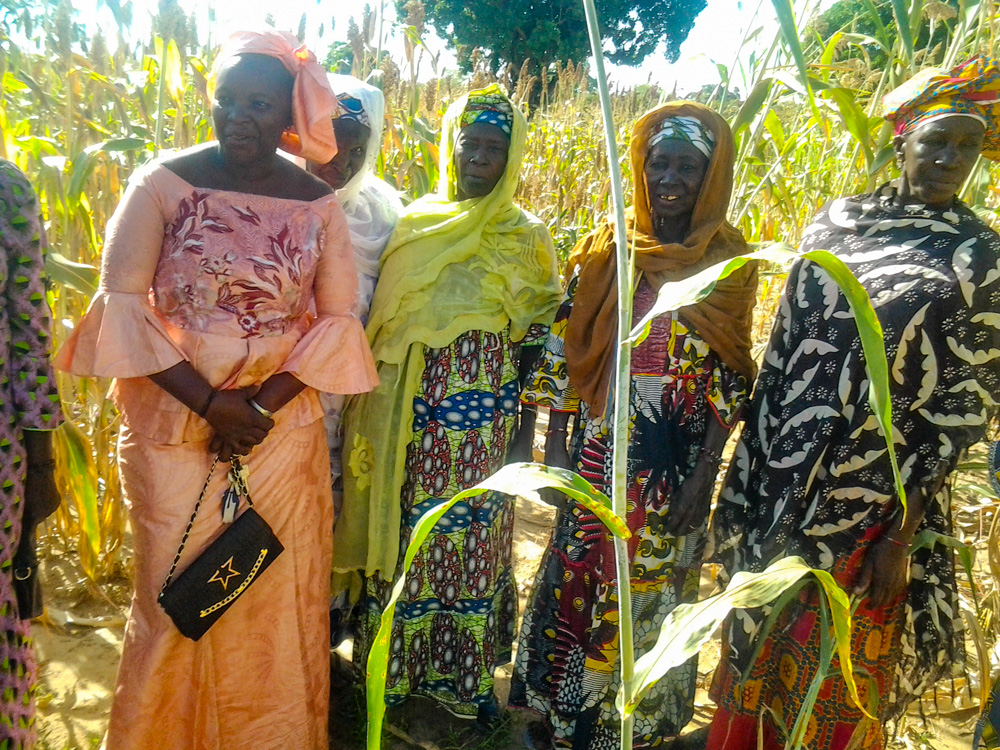
Some of the women who participated in the assessment of a sorghum field trial at Cinzana Research Station. Photo: Aly Boubacar
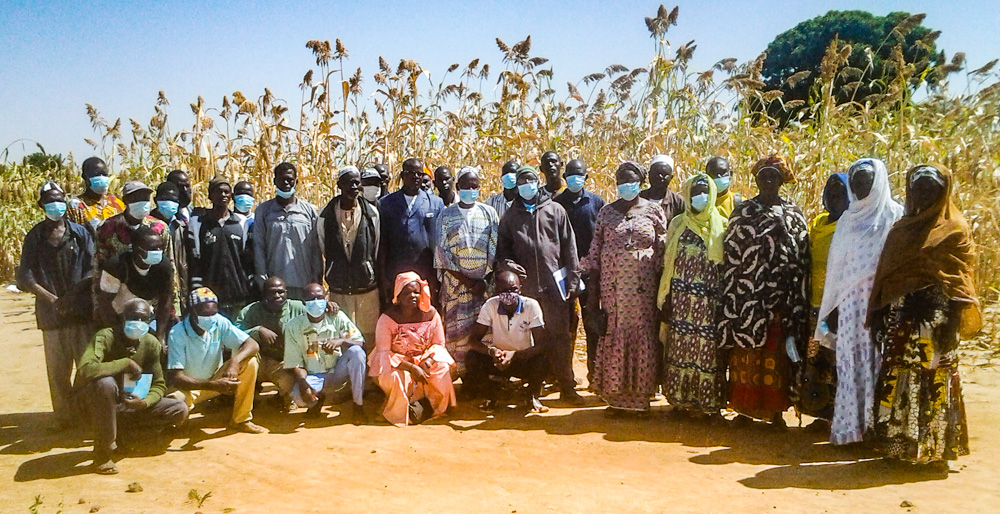
Farmers of the Union des Agriculteures du cercle de Tominian (UACT), farmers from Cinzana and extension agents from the Cinzana Agronomic Research Station at Cinzana Research Station, Mali in November 2020 after assessing a field trial of crosses between wild and cultivated sorghum. Photo: Aly Boubacar
Local farmers lending their voice
Experienced farmers in Mali are collaborating with breeders to evaluate sorghum derived not only from local crosses but also material from as far away as Australia.
“The CWR Project built on foundations laid over many years by researchers and farmers in Mali, with support from ICRISAT [International Crops Research Institute for the Semi-Arid Tropics] and others,” said Aly Boubacar, a sorghum breeder with the Institut d’Economie Rurale and leader of the sorghum breeding project in Mali.
With a career spanning nearly 40 years, Aly is at the forefront of sorghum breeding in Mali. “This three-year project helped us select lots of hidden sorghum diversity which holds promise for eventual release on a national level.”
Local farmers, like Moïse, played a key role in making those selections. Countless generations of farmers have grown sorghum in Mali, where the crop plays an integral role in life and culture today.
The farmers of Mali are open minded when it comes to the sorghum diversity in their fields. Each household typically cultivates two or more varieties, and often more than 20 varieties are cultivated in a village.
“Sorghum farmers in Mali have a well-developed eye for diverse panicle, grain and glume characteristics,” said Eva Weltzien, an expert in participatory plant breeding who served as a consultant for the CWR Project.
Eva has developed a keen eye herself for sorghum, having worked with the crop in West Africa as a breeder for 20 years, but she knows her limitations. “Farmers can detect differences that breeders fail to notice, and they can alert breeders to traits which might have been overlooked.”
The drooping panicle which Moïse appreciated is a good example. “Many sorghum breeders strive for the compact, erect panicles that are common in many other parts of the world,” Eva said. “But Malian farmers value drooping panicles, because they can defend the crop from attack by birds and diseases as they sway in the wind.”
The farmers in Mali identified several other important traits during the project, which included 60 on-farm trials involving 151 new sorghum lines. These traits include retention of green tissue, resistance to lodging (falling over) in severe wind, ease of threshing, tolerance to excess water during mid-season extreme rainfall periods, high grain yield, and earlier maturity for coping with an early end of the rainy season.
“Some of these traits are not routinely observed by breeders,” said Colette Ouindiam Ouedraogo, a sorghum breeder who painstakingly worked to develop the breeding lines the farmers were evaluating. “They could prove vital as we try to develop new varieties that enhance the resilience of Sahelian farmers’ sorghum production in the context of climate change.”
Farmers gaining confidence
The experience in Mali shows how farmers and scientists can usefully collaborate, giving each other feedback on their favorite sorghums and discussing the underlying criteria for their choices. “Formal methods, such as farmer voting for, or selecting, material in evaluation trials, as well as informal discussions between breeders and farmers, are now routine practices,” said Eva. “This way breeders and farmers can really work together.”
One of the long-lasting benefits of the project is that participating farmers from UACT are no longer shy to discuss their concerns and observations, and share their own experiences, with the scientists. According to Aly, the farmers now “tell us what they want.”
“The contributions of individual farmers and the positive group dynamics among UACT members were very impressive,” said Aly. “The farmers showed pride in explaining their choices of sorghums that best meet their interests and needs.”
“Farmers like Moïse are now also breeders. We are now connected, we’re on the same team, we’re family,” said Aly. “With the strength and importance of family ties in Mali, and also football, that’s saying a lot.”
###
Categories: Crop Wild Relatives, Sorghum
About the Crop Wild Relatives Project
The Crop Wild Relatives Project was developed to collect important species of crop wild relatives, ensure their long-term conservation and facilitate their use in breeding new, improved crops. This 11-year project was launched in 2011 with USD 50 million in funding from the Government of Norway. Managed by the Crop Trust with the Royal Botanic Gardens, Kew, the project was implemented in partnership with national and international genebanks and plant breeding programs around the world. The work is continuing under the “Biodiversity for Opportunities, Livelihoods and Development” (BOLD) Project, which is also funded by the Government of Norway.


